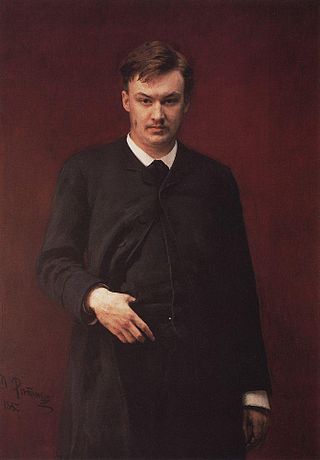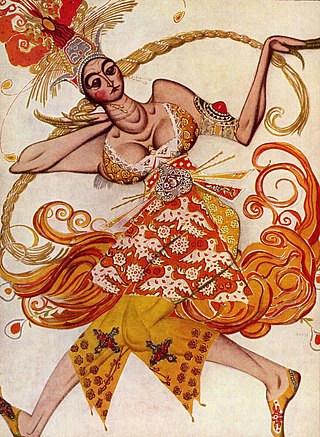A time signature is a convention in Western music notation that specifies how many note values of a particular type are contained in each measure (bar). The time signature indicates the meter of a musical movement at the bar level.

Igor Fyodorovich Stravinsky was a Russian composer and conductor with French citizenship and American citizenship. He is widely considered one of the most important and influential composers of the 20th century and a pivotal figure in modernist music.

Nikolai Andreyevich Rimsky-Korsakov was a Russian composer, a member of the group of composers known as The Five. He was a master of orchestration. His best-known orchestral compositions—Capriccio Espagnol, the Russian Easter Festival Overture, and the symphonic suite Scheherazade—are staples of the classical music repertoire, along with suites and excerpts from some of his fifteen operas. Scheherazade is an example of his frequent use of fairy-tale and folk subjects.

The Five, also known as the Mighty Handful or The Mighty Five, were five prominent 19th-century Russian composers who worked together to create a distinct national style of classical music: Mily Balakirev, César Cui, Modest Mussorgsky, Nikolai Rimsky-Korsakov and Alexander Borodin. They lived in Saint Petersburg and collaborated from 1856 to 1870.
An octatonic scale is any eight-note musical scale. However, the term most often refers to the ancohemitonic symmetric scale composed of alternating whole and half steps, as shown at right. In classical theory, this symmetrical scale is commonly called the octatonic scale, although there are a total of 43 enharmonically inequivalent, transpositionally inequivalent eight-note sets.

Alexander Konstantinovich Glazunov was a Russian composer, music teacher, and conductor of the late Russian Romantic period. He was director of the Saint Petersburg Conservatory between 1905 and 1928 and was instrumental in the reorganization of the institute into the Petrograd Conservatory, then the Leningrad Conservatory, following the Bolshevik Revolution. He continued as head of the Conservatory until 1930, though he had left the Soviet Union in 1928 and did not return. The best-known student under his tenure during the early Soviet years was Dmitri Shostakovich.

The Firebird is a ballet and orchestral concert work by the Russian composer Igor Stravinsky. It was written for the 1910 Paris season of Sergei Diaghilev's Ballets Russes company; the original choreography was by Michel Fokine, who collaborated with Alexandre Benois and others on a scenario based on the Russian fairy tales of the Firebird and the blessing and curse it possesses for its owner. It was first performed at the Opéra de Paris on 25 June 1910 and was an immediate success, catapulting Stravinsky to international fame and leading to future Diaghilev–Stravinsky collaborations including Petrushka (1911) and The Rite of Spring (1913).

Sadko is an 1898 opera in seven scenes by Nikolai Rimsky-Korsakov. The libretto was written by the composer, with assistance from Vladimir Belsky, Vladimir Stasov, and others. Rimsky-Korsakov was first inspired by the bylina of Sadko in 1867, when he completed a tone poem on the subject, his Op. 5. After finishing his second revision of this work in 1891, he decided to turn it into a dramatic work.

Bulgarian folk dances are intimately related to the music of Bulgaria. This distinctive feature of Balkan folk music is the asymmetrical meter, built up around various combinations of 'quick' and 'slow' beats. The music, in Western musical notation, is often described using compound meter notation, where the notational meter accents, i.e., the heard beats, can be of different lengths, usually 1, 2, 3, or 4. Many Bulgarian dances are line dances, in which the dancers dance in a straight or curved line, holding hands.
Pajdushko horo; is a folk dance from macedonian region In Bulgaria and North Bulgaria. It features a 5-beat meter divided into "quick" (2-beat) and "slow" (3-beat) units, abbreviated quick-slow or 2+3.time. Like many other Balkan folk dances, each region or village has its own version of the dance. It is traditionally a men's dance, but in modern times it is often performed in lines of both men and women.
Kopanitsa or kopanica is the name for a family of lively folk dances from western Bulgaria done to music in 11
8 meter, and also sometimes for the accompanying music. Some sources describe the rhythm in terms of "quick" and "slow" beats, the pattern being quick-quick-slow-quick-quick. The name comes from the verb kopam, which means "to dig" or "to hoe", so the name is sometimes translated as "little digging dance". As with other Balkan dances, different regions and even different villages have their own variations of the dance.
Piano-Rag-Music is a composition for piano solo by Igor Stravinsky, written in 1919.
Dajchovo horo is a Bulgarian folk dance done to a nine-beat meter. It is unique in two ways: it is a circle dance, and yet it has a leader.
Pravo horo is a very popular, simple folk dance from Bulgaria that is done throughout the Balkan countries. In Greece, it is called Zonaradiko. It is considered the "national dance" of Bulgaria, Albania, and North Macedonia. It is a rustic village line dance with a three-measure pattern, done to 2
4 or 6
8 music, and is a staple of weddings, feast days, and other celebrations. As with other Balkan dances, each country and even local region has its own variation of the dance, often interspersing other steps with the basic pravo step, to the extent that these different versions amount to distinct dances.

The Nikolai Rimsky-Korsakov Memorial Museum-Apartment is a branch of the St. Petersburg State Museum of Theatre and Music.
The Symphony in E-flat, Op. 1, is the first published work composed by Igor Stravinsky during his apprenticeship with Nikolai Rimsky-Korsakov. It is also his first composition for orchestra. Of classical structure, it is broadly influenced by Rimsky-Korsakov, Glazunov, Tchaikovsky and Wagner. It was composed in 1905–1907 and revised in 1913. It lasts for about forty minutes.
Scherzo fantastique, op. 3, composed in 1908, is the second purely orchestral work by Igor Stravinsky. Despite the composer's later description of the work as "a piece of 'pure', symphonic music", the work was inspired by Maurice Maeterlinck's 1901 essay "La Vie des Abeilles", as is made clear in a letter of 18 June 1907 from the composer to his teacher Rimsky-Korsakov. Ten years later, Léo Staats adapted it as a ballet for the Opéra Garnier, with the title Les Abeilles, which was objected to by Maeterlinck.
Petrunino horo is a Bulgarian dance from the Shopluk region in middle-west Bulgaria.
Funeral Song, Op. 5, is an orchestral work by Igor Stravinsky. Composed in 1908 in memory of Nikolai Rimsky-Korsakov, the work received one performance in 1909. The work was then lost and not rediscovered until 2015.









